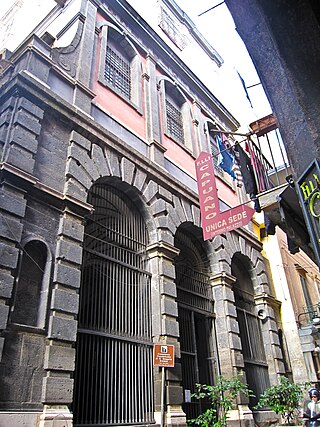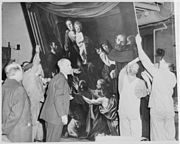
Michelangelo Merisi da Caravaggio, known mononymously as Caravaggio, was an Italian painter active in Rome for most of his artistic life. During the final four years of his life, he moved between Naples, Malta, and Sicily until his death. His paintings have been characterized by art critics as combining a realistic observation of the human state, both physical and emotional, with a dramatic use of lighting, which had a formative influence on Baroque painting.

Guido Reni was an Italian painter of the Baroque period, although his works showed a classical manner, similar to Simon Vouet, Nicolas Poussin, and Philippe de Champaigne. He painted primarily religious works, but also mythological and allegorical subjects. Active in Rome, Naples, and his native Bologna, he became the dominant figure in the Bolognese School that emerged under the influence of the Carracci.

The Caravaggisti were stylistic followers of the late 16th-century Italian Baroque painter Caravaggio. His influence on the new Baroque style that eventually emerged from Mannerism was profound. Caravaggio never established a workshop as most other painters did, and thus had no school to spread his techniques. Nor did he ever set out his underlying philosophical approach to art, the psychological realism which can only be deduced from his surviving work. But it can be seen directly or indirectly in the work of Rubens, Jusepe de Ribera, Bernini, and Rembrandt. Famous while he lived, Caravaggio himself was forgotten almost immediately after his death. Many of his paintings were re-ascribed to his followers, such as The Taking of Christ, which was attributed to the Dutch painter Gerrit van Honthorst until 1990.

Death of the Virgin (1606) is a painting by the Italian Baroque master Caravaggio depicting the death of the Virgin Mary. It is part of the permanent collection of the Musée du Louvre, in Paris.

Museo di Capodimonte is an art museum located in the Palace of Capodimonte, a grand Bourbon palazzo in Naples, Italy designed by Giovanni Antonio Medrano. The museum is the prime repository of Neapolitan painting and decorative art, with several important works from other Italian schools of painting, and some important ancient Roman sculptures. It is one of the largest museums in Italy. The museum was inaugurated in 1957.

Giovanni Battista Caracciolo (1578–1635) was an Italian artist and important Neapolitan follower of Caravaggio. He was a member of the murderous Cabal of Naples, with Belisario Corenzio and Giambattista Caracciolo, who were rumoured to have poisoned and disappeared their competition for painting contracts.
Giulio Mancini was a seicento physician, art collector, art dealer and writer on a range of subjects. His writings on contemporary artists like Caravaggio and Annibale Carracci remain one of our earliest sources of biographical information; his Considerazioni being an important source on art in early 17th-century Rome.

San Gregorio Armeno is a church and a monastery in Naples, Italy. It is one of the most important Baroque complexes in Naples. The church is located on a street of the same name just south of Via dei Tribunali and a few blocks south of the church of San Paolo Maggiore, Naples

Sant'Anna dei Lombardi,, and also known as Santa Maria di Monte Oliveto, is an ancient church and convent located in piazza Monteoliveto in central Naples, Italy. Across Monteoliveto street from the Fountain in the square is the Renaissance palace of Orsini di Gravina.

Santa Maria della Scala is a titular church in Rome, Italy, located in the Trastevere rione. Cardinal Ernest Simoni took possession of the titular church on 11 February 2017. Santa Maria della Scala is a titular church.

Francesco Bonsignori, also known as Francesco Monsignori, was an Italian painter and draughtsman, characterized by his excellence in religious subjects, portraits, architectural perspective and animals. He was born in Verona and died in Caldiero, a city near Verona. Bonsignori's style in early period was under the influence of his teacher Liberale da Verona. After becoming the portraitist and court artist to the Gonzaga family of Mantua in 1487, his style was influenced by Andrea Mantegna, who also worked for Francesco Gonzaga from the 1480s. They collaborated to execute several religious paintings, mainly with the theme of Madonna and Child. The attribution of theportrait of a Venetian Senator was debatable until the last century because of the similarity in techniques used by Bonsignori and his teacher Mantegna. During the phase of his career in Mantua, there is an undocumented period between 1495 and July 1506 with no official record regarding his activities by the court of Mantua. Bonsignori's late style was decisively influenced by Lorenzo Costa in terms of form and color. He produced his last monumental altarpiece the Adoration of the Blessed Osanna Andreasi in 1519 shortly before his death.

The Church of Sant'Egidio is located in the historic center of Mantua on Via Pietro Frattini. A church was located on the site likely by the 9th century, but is documented from the year 1151 in a bull by Pope Eugenius III. In 1540, the chapel of the Valenti was built, commissioned by the last will of Valente Valenti, courtier in the Gonzaga Duchy. Beginning in 1721, the church underwent a major reconstruction, and the present facade dates to that time. In 1777, the cardinal Luigi Valenti reconstructed the family chapel.

Louis Finson, Lodewijk Finson or Ludovicus Finsonius was a Flemish painter, draughtsman, copyist and art dealer. He painted portraits, religious compositions, allegorical paintings and genre scenes. Moving to Italy early in his career, he became one of the first Flemish followers of Caravaggio whom he knew personally in Naples. He produced a number of copies after works by Caravaggio. He worked for a number of years in various cities in France where he created altarpieces and portraits. He is known for being the co-owner together with his fellow Flemish painter and business partner Abraham Vinck of two paintings by Caravaggio. Louis Finson played a major role in the Northern Caravaggesque movement through his own works as well as his role as an art dealer.

The Church of Santa Maria di Caravaggio is a Baroque Catholic church located on Piazza Dante, in Naples, Italy.

Santa Maria Egiziaca a Forcella is a Baroque-style, Roman Catholic church located in the quartiere di Forcella, in the city of Naples, Italy;

Ippolita Gonzaga was an Italian noblewoman and nun. She is not to be confused with her niece Ippolita Gonzaga (1535–1563) the daughter of Ferrante Gonzaga, who married in 1549 Fabrizio Colonna, hereditary prince of Paliano, and in 1554 Antonio Carafa, duke of Mondragone.

St. Paul's Church is a Roman Catholic church located at the Veemarkt in Antwerp, Belgium. Its exterior is mainly Gothic with a Baroque tower while the interior is characterised by its rich Baroque decoration. It holds paintings by Antwerp's leading artists Peter Paul Rubens, Anthony van Dyck and Jacob Jordaens as well as abundant sculpture and church furniture crafted by leading Antwerp sculptors such as Artus Quellinus the Elder, Pieter Verbrugghen I, Jan Pieter van Baurscheit de Elder, Jan Claudius de Cock and Andries Colyns de Nole. Of particular note is the Calvary outside the Church which is made up of 63 life-size statues and nine reliefs executed in a popular and theatrical style.

The Palazzo Zevallos Stigliano is a Baroque palace located on Via Toledo number 185 in the quartiere San Ferdinando of central Naples, Italy. It is also called the Palazzo Zevallos or Palazzo Colonna di Stigliano, and since 2014 serves as a museum of artworks, mainly spanning the 17th through the early 20th centuries, sponsored by the Cultural Project of the bank Intesa Sanpaolo. This museum is linked to the Museum or Gallerie di Piazza Scala in Milan and the Museum at Palazzo Leoni Montanari in Vicenza, also owned by the Bank.
Siro Baroni was an Italian painter of the late-Baroque period, active in Mantua.

Abraham Vinck or Abraham Willemsz. Vinck was a Flemish painter and art dealer who spent most of his life and career outside of Flanders, including in Hamburg, Naples and Amsterdam. He is mainly known as a portrait painter but also practised in many other genres including history painting, mythological scenes, fruit and fish still lifes and market scenes. He was also a copyist who created copies after the great masters. He is now mainly known for being the co-owner together with his Flemish colleague and business partner Louis Finson of two paintings by Caravaggio.



















